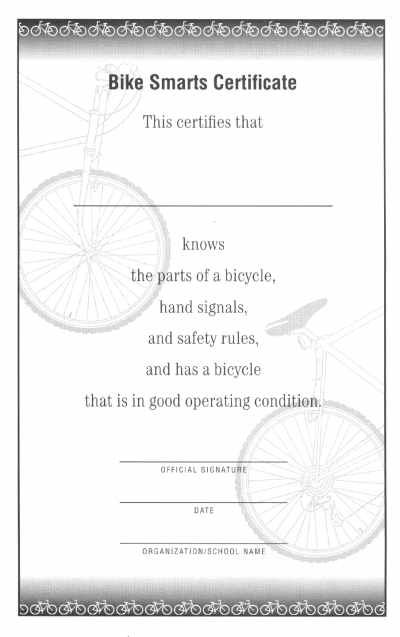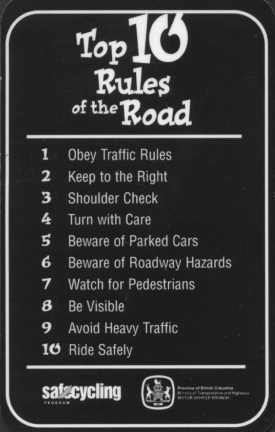Bike Smarts
The Bike Smarts program was introduced in Lochside Elementary School to educate students about bicycle safety and to encourage them to travel by bicycle. As part of the program, parents of the students became involved in cycling to school with their children and participated in a cycling field trip.
Background
In 1996, Lochside Elementary School in Victoria, British Columbia, used the Bike Smarts public education program initiated by the B.C. Ministry of Transportation and Highways to provide teachers and cycling instructors with the tools for teaching children bicycle safety and to encourage bicycle use.
Delivering the Program
Bike Smarts was a provincial program that promoted bicycle safety among students between the ages of seven and thirteen. Launched in February 1996, Bike Smarts elicited interest by sending information to each school, conducting information sessions at teachers' conferences, and providing a contact point for instructors to get help at any time. The program package sent to the schools that registered included:
- a handbook
- a helmet safety video
- a Bike Smarts poster
- supplementary material
- a survey to be completed by instructors
Twenty-eight students in the grade 4 class at Lochside Elementary School participated in the bicycle safety program conducted for a six-week period in May and June of 1996 (School Programs that Involve the Family). Information brochures from Bike Smarts, consent forms, and bicycle maintenance forms were sent home with the children to keep parents informed and help increase their awareness of bicycling safety.
The children received in-class instruction on riding safety and took part in five neighbourhood trips to practise their riding skills. Students, with their parents, were also encouraged to cycle to and from school. To complete the program, they were required to pass both a written test and an "on-bike" cycling skills test. The highlight of the program was a 30-km bicycle trip to Saltspring Island (15 km each way) where a barbecue and activities were organized. To qualify for the field trip, the students were required to have cycled 100 km during the six-week period and to have kept a journal of how far they had travelled. Parental participation was strongly encouraged on the neighbourhood outings and the field trip.
The children were highly motivated to take part in the program because they looked forward to the field trip. The neighbourhood outings and field trip were also all held during school time; being able to "get out of school" was very appealing.
The major barrier to children riding to and from school was not a lack of interest on the part of the students, but a lack of family support arising from safety concerns. This barrier was overcome by keeping parents informed, stressing safety, and encouraging parents to participate so they could see for themselves the skills the children were acquiring (Overcoming Specific Barriers). It was hoped that parents would continue to ride with their children after the program had ended.
Measuring Achievements
In the fall of 1996 a survey was sent home with each participant to be filled out by the parents. The questionnaire was used to determine parents' attitudes on how well the program had succeeded in teaching the children bicycle safety. It also served to obtain information about how often the students and parents cycled, both before and after the program. Sixteen surveys were completed and returned.
Results
- Most of the parents allowed their children to ride to school more often after the program. This was apparently related to the program making it safer for their children to cycle.
- As a direct result of the program, 4 of the 16 parents reported cycling at least 20 percent more than they used to, two of them 40 percent to 50 percent more.
- All of the parents thought that their children's motivation for cycling had increased since participating in the program.
Contacts
JW Sporta --Bike Smarts
1367 West Broadway
Suite 228
Vancouver, British Columbia
V6H 4A0 (604) 738-2468
Fax: (604) 737-6043
E-mail: consult@jwsporta.ca
Notes
Last updated: July 2004. This case study was originally published in 1998 in "Tools of Change: Proven Methods for Promoting Environmental Citizneship" by Jay Kassirer and Doug McKenzie-Mohr (Published by Canada's National Round Table on the Environment and the Economy)
Search the Case Studies



